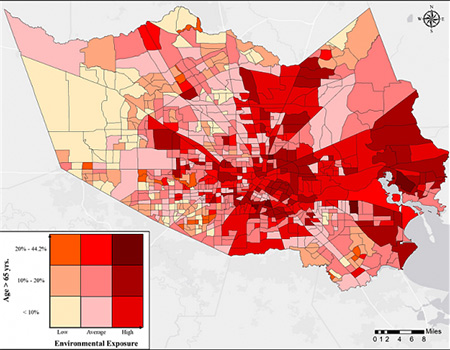
Project Summary: Enhancing COVID-19 Response through Targeted Risk Assessment and Planning
Lead Researchers: Dr. Hanadi Rifai, Professor of Civil and Environmental Engineering; Dr. Winston Liaw, Professor of Health Systems and Population Health Sciences; Dr. Amin Kiaghadi, Postdoctoral Fellow; HuRRI (Harris County Resilience and Infrastructure)
Three researchers from the Harris County Resilience and Infrastructure (HuRRI) have developed a proactive planning tool to identify vulnerable segments of the population most in need of COVID-19 testing and support. Dr. Hanadi Rifai, Dr. Winston Liaw, and Dr. Amin Kiaghadi collaborated on the project titled "Assessing COVID-19 Risk, Vulnerability and Infection Prevalence in Communities." The research focuses on identifying at-risk populations in advance using census data to guide targeted resource allocation and support efforts.
Goals:
The primary goal of this research is to assess COVID-19 risk, vulnerability, and infection prevalence in communities, with a specific focus on identifying populations at higher risk for transmission and adverse outcomes. By developing a comprehensive tool based on demographic and environmental factors, the research aims to guide policymakers in proactively allocating resources to communities with a higher potential for becoming COVID-19 hotspots. The ultimate objective is to ensure that public resources, including equipment, personnel, medications, and support, are efficiently matched with the needs of the most vulnerable and high-risk populations.
Methods:
The research team utilized preliminary analyses to identify specific population groups at higher risk of COVID-19 transmission and death. The tool categorizes at-risk populations into five categories:
- People with limited access to hospitals and medical care.
- People with underlying medical conditions, such as respiratory illnesses and hypertension.
- People with higher environmental exposures like air pollution and water contamination.
- People in areas vulnerable to natural disasters and flooding.
- People with specific lifestyle factors, like obesity, drinking, and smoking.
Census data is employed to develop a spatial tool that policymakers can use to identify neighborhoods with elevated potential for becoming COVID-19 hotspots. This allows for targeted resource allocation and support, particularly for communities with a higher concentration of vulnerable populations.
Key Findings:
The researchers found that economically disadvantaged communities, those near the Houston Ship Channel, and areas in the east and northeast parts of Harris County had the highest overall risk based on all five categories. Conversely, populations with the least combined risk factors were found in the western fringes of Harris County. Residents in the Houston Ship Channel neighborhoods were identified as having less favorable socio-demographics, exposure to various chemicals, and susceptibility to flooding.
Based on 2018 census tract data, approximately 17 percent of Harris County's population (722,357 residents) falls into at least one risk category. Among this group, 171,403 are between 45 and 65 years old, and 76,719 are 65 years old or greater—both higher-risk groups for severe outcomes from COVID-19.
Impact and Implications:
The research aligns with HuRRI's mission, focusing on resilience dimensions of Mitigation, Assessment, Prediction, Protection, Education, and Recovery (MAPPER). By providing a targeted risk assessment tool, the research contributes to effective pandemic response, guiding policymakers in addressing the needs of vulnerable populations efficiently. The findings have implications for improving the social safety net during pandemics, emphasizing the importance of factors like proximity to healthcare facilities in determining outcomes. The tool developed through this research can be instrumental in enhancing community resilience to future health crises. The full paper, "Assessing COVID-19 Risk, Vulnerability and Infection Prevalence in Communities," is available on medRxiv.